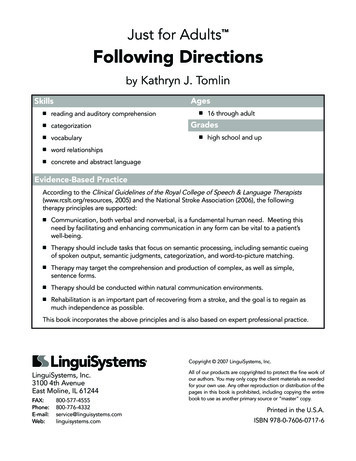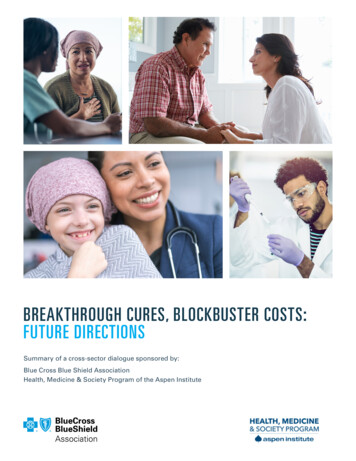
Transcription
U.S. Department of JusticeOffice of Justice ProgramsOffice for Victims of CrimeNewDirectionsfrom theField:Victims’ Rights and Servicesfor the 21st CenturyNCJ 170600
New Directions from the Field:Victims’ Rights and Services for the 21st CenturyCONTENTSForewordiiExecutive SummarySection I: New Directions in Victims’ RightsChapter 1: Victims’ RightsSection II: New Directions for Criminal and Juvenile JusticeSystem AgenciesChapter 2:Chapter 3:Chapter 4:Chapter 5:Law EnforcementProsecutionJudiciaryCorrectionsSection III: New Directions for Victim Asssistance andAllied ProfessionsChapter 6: New Directions for the Victim Assistance CommunityChapter 7: The Health Care CommunityChapter 8: The Mental Health CommunityChapter 9: The Legal CommunityChapter 10: The Educational CommunityChapter 11: The Faith CommunityChapter 12: The Business CommunityChapter 13: The News Media CommunitySection IV: New Directions in Financial RecoveryChapter 14: Crime Victim CompensationChapter 15: RestitutionChapter 16: Civil RemediesSection V: New Directions for Child VictimsChapter 17: Child VictimsSection VI: New Directions in International Victim AssistanceChapter 18: International Perspectives in Victim 3323325355373381383413415Conclusion429Appendix A: Contributors to New DirectionsA-1Appendix B: Staff of New DirectionsB-1i
New Directions from the Field: Victims’ Rights and Services for the 21st CenturyForewordFifteen years have passed since the chair of the 1982 President’sTask Force on Victims of Crime called the neglect of crime victims inthe United States a national disgrace.Today, we can be proud that ournation listened and responded to victims and their advocates.Victims’rights laws have been enacted in every state, more than 10,000victim assistance programs have been developed around the country,and every state has established a crime victim compensationprogram.The creation of a federal Crime Victims Fund, which wasfirst proposed by the task force, has provided more than 2.3 billionfrom fines paid by federal criminal offenders to support many ofthese lifeline services for victims.But even today, too many victims and their families are not activeparticipants in the criminal or juvenile justice process. In the words ofPresident Clinton, they are still “on the outside looking in.”They aredenied meaningful participation in the justice system and services tomeet their most basic needs.Victims’ rights laws vary significantly fromstate to state and often remain unenforced. For millions of victimizedAmericans, the system still hurts more than it helps.This document—New Directions from the Field:Victims’ Rights andServices for the 21st Century—is a comprehensive report and set ofrecommendations on victims’ rights and services from and concerningvirtually every community involved with crime victims across thenation.The report is the result of more than three years’ work by morethan 1,000 individuals in different professions. It examines howvictims’ rights and services have been realized since the 1982 FinalReport of the President’s Task Force and recommends what we as asociety should strive to achieve for victims as we enter the 21stcentury.While the recommendations may not reflect all of the individual contributors’ views, the contributors agree that all of therecommendations are worthy of discussion and consideration.The work of these individuals and the publication and dissemination of this material has been supported by the Office for Victims ofCrime (OVC) of the United States Department of Justice.The reportand recommendations represent views from the field, however, and donot necessarily reflect the views of the Department of Justice.We aregrateful to the Department of Justice for providing resources so thisimportant document could be developed and made widely available.ii
ForewordThe Authors and ProcessNew Directions incorporates views from the field—including crimevictims, representatives from national victim advocacy and serviceorganizations, criminal justice practitioners, allied professionals, andmany others—who provided the background materials and recommendations contained in this action plan.That group includes 32 nationallyrecognized experts who developed background papers on the areasaddressed in this report.The ideas and proposals in the backgroundpapers were enhanced by the comments of nearly 100 expert reviewers. Many individuals from the criminal justice and victim service fieldsprovided substantive input into this document through expertsummits; public hearings; focus groups of representatives from thejudiciary, law enforcement, prosecution, and corrections, the faithcommunity, and the crime victim compensation field; and symposia onhate and bias crimes, workplace violence, and the news media.Additional input was obtained in 1997 from state administrators ofVictims of Crime Act (VOCA) assistance programs from all 50 states.Further program information on “promising practices” was derived fromOVC grant projects in the areas of law enforcement, prosecution, corrections, probation and parole, victims of juvenile offenders, death notification, rural victims, technology, and victim involvement with communityservice. In late 1997, meetings of leaders in the crime victims field wereheld to review and finalize the recommendations. All who participatedin those meetings were impressed by the scope and innovation of thecollective work of the field that is presented in New Directions.On behalf of all those committed to improvement of services tocrime victims, we express our deep appreciation to the Department ofJustice for its financial support of this effort.We are especially gratefulto Aileen Adams, who served as Director of OVC during the core 3years of this project’s development. Her extraordinary leadershipensured that this report truly reflects the diverse views from the field.Moreover, her commitment to justice and healing served as a guidingforce to listen to the voices of crime victims across America as “newdirections” were identified.We also want to acknowledge currentActing Director Reginald Robinson for his support in bringing NewDirections to publication and in ensuring that this report is widelydisseminated throughout the nation.A project of this magnitude requires the hard work of many individuals. Ashley Oliver Barrett, Special Assistant to the Director, deservesspecial distinction for her tireless efforts in every aspect of this remarkable endeavor, not the least of which was guiding this document throughfinal publication.We are also grateful for the outstanding work of formerOVC staff members Katia Garrett, who provided keen legal analysis andinsight into the many complicated issues addressed in this report, as welliii
New Directions from the Field: Victims’ Rights and Services for the 21st Centuryas Sharon English and Melanie Smith, for their efforts in laying thefoundation of New Directions. Many other OVC staff deserve specialthanks for the guidance and insight they provided along the way.Christine Edmunds, who joins us in signing this foreword, alsoshould be recognized for her exceptional work over the past 3 years indeveloping this report.As a consultant to OVC for New Directions, Ms.Edmunds conducted extensive research to amplify sections of thedocument, identified additional promising practices, shaped andrefined ideas and recommendations, and wove together the information obtained from the field to present in this report.Finally, the essential contributions of crime victims themselves mustbe acknowledged.Victims presented their views and priorities duringhearings and forums, as members of advisory boards on grants, infocus groups, and as writers and researchers on this project.Theconcerns and recommendations of hundreds of victims of all ages—children, adults, and the elderly—have been invaluable in developingand shaping this report.The Challenge AheadNew Directions is intended to foster a dialogue in which variousparticipants listen to differing views, refine the report’s recommendations, and develop a strategy for providing justice and comprehensiveservices for all crime victims in the 21st century.We urge everyAmerican who interacts with victims, from police officers to prosecutors, from judges to corrections officials, from members of the clergy tobusiness leaders, to join in this dialogue and implement the programsand reforms that make sense for their own communities. During allthe years that we have worked with and on behalf of crime victims, wehave seen the doors of justice gradually open for some. It is our greathope that this report and the dialogue it fosters will move our nationcloser to the day when the doors of justice open for all victims ofcrime.With this wish, we sign this foreword on behalf of all those whocontributed to New Directions.iv
ForewordDavid BeattyAurelia Sands BelleDirector of Public PolicyNational Victim CenterArlington,VirginiaConsultant for Crime Victim IssuesFayetteville, North CarolinaChristine EdmundsBrian OgawaCriminal Justice and VictimServices ConsultantWashington, D.C.DirectorCrime Victims’ InstituteOffice of the Attorney GeneralAustin,TexasLucy FriedmanExecutive DirectorVictim ServicesNew York, New YorkSusan HermanExecutive DirectorNational Victim CenterArlington,VirginiaRalph HubbardOutreach CoordinatorParents of Murdered Children of New York StateNew York, New YorkAnne SeymourPublic Safety ConsultantWashington, D.C.John SteinDeputy DirectorNational Organization for Victim AssistanceWashington, D.C.Marlene YoungExecutive DirectorNational Organization for Victim AssistanceWashington, D.C.Janice Harris LordConsultant for Crime Victims IssuesMothers Against Drunk DrivingIrving,Texasv
Executive SummaryExecutive SummaryNew Directions from the Field:Victims’ Rights and Services for the21st Century challenges the nation to renew and refocus its efforts toimprove the treatment of victims of crime. It is the first comprehensiveplan regarding how the nation should respond to crime victims sincethe 1982 President’s Task Force on Victims of Crime identified theAmerican justice system as “appallingly out of balance,” and made 68recommendations for how rights and services for crime victims in thisnation could be substantially improved. New Directions highlights theprogress and the momentous changes that have taken place across ournation’s justice systems and in the private sector since the release of the1982 report. It identifies hundreds of innovative public policy initiativesand community partnerships that are revolutionizing the treatment ofcrime victims in America today, and it recommends improvements thatstill need to be implemented on behalf of crime victims.Today only a fraction of the nation’s estimated 38 million crime victimsreceive much-needed services such as emergency financial assistance,crisis and mental health counseling, shelter, and information and advocacywithin the criminal and juvenile justice systems.This report presentsmore than 250 recommendations targeted to nearly every profession thatcomes in contact with crime victims—from justice practitioners, to victimservice, health care, mental health, legal, educational, faith, news media,and business communities—and encourages them to redouble theirefforts to enhance victims’ rights and services.New Directions reflects views from a broad cross-section of thecriminal and juvenile justice, allied professional, and victim service fields.Contributors to this report include crime victims themselves and representatives of the agencies and organizations that serve them. Hundreds ofindividuals across the country proposed recommendations for this reportby participating in public hearings; submitting background papers ondiverse victims’ issues; serving on working groups with representativesfrom law enforcement, prosecution, and corrections agencies as well as thejudiciary; and participating in focus groups with allied professionals.Allwho contributed to this report hope that it will serve as a catalyst to adynamic and far-reaching discussion about how our nation can improve itsresponse to victims of crime, and that it will precipitate practical stepstoward making the ideas presented in this report a reality.‘New Directions’ is animportant road map forcomprehensive andconsistent rights andservices for all victims ofcrime in the 21st century.Aileen Adams,former Director,Office for Victims of CrimeNew Directions was developed by the field, and its recommendations do not necessarily reflect the views of the Justice Department orthe Office for Victims of Crime. In addition, all of the recommendationsmay not represent the views of every contributor, as over 1,000individuals provided input into this document.vii
New Directions from the Field: Victims’ Rights and Services for the 21st CenturyFive Global Challenges from the FieldSummary of RecommendationsIn the course of compiling the hundreds of recommendationsfrom the field and in listening to the voices of victims, theiradvocates, and allied professionals who work with crime victimsthroughout the nation, certain key recommendations emerged.The following five global challenges for responding to victims ofcrime in the 21st century form the core of the hundreds of ideasand recommendations presented in this report. To enact and enforce consistent, fundamental rights for crimevictims in federal, state, juvenile, military, and tribal justicesystems, and administrative proceedings. To provide crime victims with access to comprehensive,quality services regardless of the nature of their victimization,age, race, religion, gender, ethnicity, sexual orientation, capability, or geographic location. To integrate crime victims’ issues into all levels of the nation’seducational system to ensure that justice and allied professionals and other service providers receive comprehensive trainingon victims’ issues as part of their academic education andcontinuing training in the field. To support, improve, and replicate promising practices invictims’ rights and services built upon sound research,advanced technology, and multidisciplinary partnerships. To ensure that the voices of crime victims play a central role inthe nation’s response to violence and those victimized by crime.New Directions provides recommendations that point specificallyto the implementation of these five global challenges. Eachsection and chapter is based upon papers submitted by leadingexperts in the field as well as the input of victim advocates,justice system and allied professionals, crime victims, and otherswho participated in public hearings, working group meetings, andthose who provided individual comments and review as thedocument progressed towards completion.viii
Executive SummaryOrganization of New DirectionsAs an update to the 1982 Final Report of the President’s Task Forceon Victims of Crime, New Directions follows the format established inthe original report in setting forth its recommendations. It begins witha discussion of important public policy issues affecting crime victims,and each section that follows discusses how individual justice agenciesand allied professionals can implement these, as well as other,important initiatives.Additional topics and issues have been added as a result of thetremendous growth in the field and in response to new problems thathave emerged during the past 15 years. As in the original report, eachsection of New Directions contains individual chapters designed toserve as stand-alone documents that present recommendations forspecific issue areas or professions.Section INew Directions in Victims’ RightsFor many years, victims of crime were virtually invisible in the lawsand policies that govern our justice systems.To the extent victims ofcrime had a role in the justice system, it was narrow; to the extentvictims had rights, they were few.Section I, New Directions in Victims’ Rights, reviews the nation’sprogress over the past two decades toward establishing state andfederal rights for victims of crime, including a proposed federal constitutional amendment to guarantee those rights. It also presentsrecommendations from the field for ensuring that victims’ rights,including fundamental rights for victims of juvenile offenders, areexpanded and enforced within the American justice system.Tremendous strides have been made to enact victims’rights laws anddeliver services to victims in the United States.Few movements in the historyof this nation have achieved such success in igniting the kind of legislativeresponse that victim rights activists have fostered over the past two decades.In the early 1980s,state laws addressing victims rights,services,and financialreparations numbered in the hundreds.Today,there are more than 27,000crime victim-related state statutes,29 state victims’rights constitutionalamendments,and basic rights and services for victims of federal crimes.Nevertheless, serious deficiencies remain in the nation’s victims’rights laws as well as their implementation. The rights of crimevictims vary significantly among states and at the federal level.Frequently, victims’ rights are ignored. Even in states that haveenacted constitutional rights for victims, implementation is oftenarbitrary and based on the individual practices and preferences ofix
New Directions from the Field: Victims’ Rights and Services for the 21st Centurycriminal justice officials. Moreover, many states do not providecomprehensive rights for victims of juvenile offenders. In tribal,military, and administrative proceedings, the rights extended tovictims differ dramatically or do not exist at all. Many victims, including victims from diverse cultures and those with disabilities, are notinformed of their rights nor given the opportunity to participate incriminal and juvenile justice proceedings.In New Directions in Victims’ Rights, the field stronglyrecommends that the enactment and vigorous enforcement of consistent, fundamental victims’ rights should be a priority for the 21stcentury.The first recommendation from the field is for the passage ofa Federal Victims’ Rights Constitutional Amendment to establish abasic level of rights for crime victims in every state.These includethe following fundamental rights: To notice of public court proceedings and to attend them. To make a statement to the court about bail, sentencing, and accepting a plea. To notice of parole hearings and to attend them and speak. To notice of a defendant or convict’s escape or release. To an order of restitution from the convicted offender. To a final disposition of the proceedings relating to the crime freefrom unreasonable delay. To consideration for the safety of the victim in determining adefendant’s release from custody. To notice of these rights. To standing to enforce these rights.The report strongly recommends that these fundamental rightsshould be established and enforced not only in the criminal justicesystem, but also for victims in all juvenile justice, military, tribal, andadministrative proceedings.As a first step toward this goal, NewDirections recommends that the federal government, states and tribesreview their victims’ rights laws to determine if these fundamentalrights are extended to all crime victims.This report also reflects the view of the field that states and thefederal government should address the lack of implementation of manyvictims’ rights laws by establishing effective enforcement mechanismsfor victims, including victims’ rights compliance programs. Itrecommends that audits of local, state and federal compliance withvictims’ rights laws be conducted frequently by justice agencies andindependent auditors to determine the reasons for noncompliance andhow enforcement of victims’ rights can be improved.x
Executive SummaryFinally, a system of comprehensive services requires dedicatedresources.A major step toward that goal was the enactment of the 1984Victims of Crime Act, which established a creative federal fundingmechanism that relies on the collection of fines and penalties fromconvicted federal offenders rather than federal tax-based appropriations.That amount varies, however, and may not be enough to ensure consistentand comprehensive implementation of victims’ rights laws and neededservices. Many criminal justice officials and victim advocates continue toassert that there is a lack of comprehensive services in every communityfor victims of crime resulting in part from inadequate funding. New andcreative sources of funding must be identified to ensure the implementation of rights and quality services for all crime victims.Section IINew Directions for Criminal and JuvenileJustice System AgenciesWhen a person is harmed by a criminal act, the agencies that make upour criminal and juvenile justice systems have a moral and legal obligation to respond. It is their responsibility not only to seek swift justice forvictims, but to ease their suffering in a time of great need. Section II,New Directions for Criminal and Juvenile Justice System Agencies,discusses the critical role that each agency within the justice system—law enforcement, prosecution, judiciary, and corrections—must play inimplementing and enforcing victims’ rights and in improving the overalltreatment of crime victims within our nation’s justice systems.Chapter Two, New Directions for Law Enforcement, addresses lawenforcement’s role as the frontline of victim assistance.As the firstresponders to reported crimes, law enforcement agencies must ensurethat victims are treated with sensitivity and provided with essentialinformation and emergency assistance.This chapter addresses innovations including law enforcement-based victim assistance units; on-scenecrisis units where specially trained counselors and law enforcementofficers respond together to victims; and multidisciplinary programsthat have been launched in hundreds of law enforcement agenciesacross the nation to respond to the needs of child, elderly, domesticviolence and sexual assault victims. A number of recommendations forthe law enforcement community are advanced by the field. Forexample, law enforcement agencies should adopt community policingphilosophies that are both victim and crime prevention oriented.Thefield also recommends that law enforcement agencies establish policiesand procedures for the provision of legally mandated victims’ rights andservices such as notifying victims of the status of an investigation,arrests, and pretrial release of suspects in their custody. In addition,compliance with victims’ rights policies and procedures should beincluded as a standard in officers’ performance appraisals.xi
New Directions from the Field: Victims’ Rights and Services for the 21st CenturyChapter Three, New Directions for Prosecution, addresses ournation’s prosecutors.Today, prosecutors are recognizing that to mosteffectively prosecute a case, the victim must be part of the process.The chapter highlights programs such as special prosecution units forchild abuse, sexual assault, and domestic violence; victim/witnessassistance programs that provide comprehensive information, notification, advocacy, and support to crime victims; and community prosecution initiatives.This chapter also contains several recommendationsthat specifically address the prosecutor’s role in informing, consultingwith, and notifying crime victims. For example, because theoverwhelming majority of felony cases are resolved through pleaagreements, the field recommends that prosecutors consult withvictims on the terms of any negotiated plea.The field also recommendsthat prosecutors confer with victims of violent crimes before decliningto file charges. Other recommendations for prosecutors include theneed to notify victims in a timely manner of public court proceedingsand to advocate for their rights to be heard regarding bail decisions,continuances, sentencing, and restitution.The field also recommendsthat prosecutors and leaders of victims’ organizations developprotocols for ensuring appropriate notification and consultation incases involving large numbers of crime victims.Chapter Four, New Directions for the Judiciary, addresses thepivotal role that judges play in the justice process. The judiciary hasinitiated many victim-sensitive problem-solving efforts such as specialized drug courts; domestic violence courts; community courts thathandle “quality of life” misdemeanor crimes; unified family courts thathandle all problems relating to the family including criminal, civil, andjuvenile matters; and courts designed specifically for child victims. Thereport recommends that as leaders within the justice system, judgesshould ensure that victims’ rights laws are fully implemented. NewDirections recommends that judges should advise victims of theirrights as routinely as they advise defendants of their rights and shouldfacilitate the input of crime victims regarding proposed pleaagreements. In addition, judges should permit the victim to present avictim impact statement before imposing a sentence, and courts shouldutilize communications technology (audio/video) to facilitate victimcommunication. The field also recommends that judges manage theircases and calendars to make victim involvement as feasible as possible,and that they order full restitution from offenders to help compensatevictims for the harm they have suffered.The last chapter in this section, New Directions for Corrections,encompasses the adult and juvenile justice agencies responsible for theincarceration, detention, supervision, and surveillance of those accusedor convicted of committing crimes. Over the past decade, the basicphilosophy of correctional agencies has undergone radical change.xii
Executive SummaryTraditionally, correctional agencies viewed their role as limited topunishing and rehabilitating offenders.Today, serving crime victims isalso widely accepted as an important part of the mission of manycorrectional agencies. This new role is reflected in their governing lawsand internal policies and procedures, as well as in the attitudes ofcorrectional personnel. More work is needed in this area, however. Thefield recommends that adult and juvenile correctional agencies openchannels of communication with the community and with crimevictims; that correctional agencies designate staff to provide information, assistance, and referrals to victims of crime; that they place a highpriority on ensuring the protection of victims from inmate intimidation,threats, physical or other harm from offenders under their supervision;and that they inform victims of any change in the status of offendersthat would give them access to victims or the community.To increaseoffender awareness of the consequences of their actions, correctionalagencies for both adult and juvenile offenders should use victim impactpanels and conduct courses on the effects of crime on victims.New Directions for Criminal Justice System Agencies emphasizesthe need for all criminal and juvenile justice personnel to ensure thatthe voices of victims are heard throughout the criminal justice processso that justice agencies are able to develop effective, victim-sensitivepolicies and programs. Education for these professionals should includepresentations by victims about their justice system experiences. Crimevictims are the “customers” of that system, and the agencies thatinteract with victims have an obligation to ask them to evaluatewhether their needs are being met.Section IIINew Directions for Victim Assistance andAllied ProfessionalsMembers of many different professions work directly with crimevictims or come into contact with them on a daily basis. In addition tovictim service providers, primary among these are professionals in thehealth care, mental health, legal, education, faith, business, and thenews media communities. New Directions for Victim Assistance andAllied Professionals describes the important roles that these professions can play in assisting victims. It identifies areas where services forvictims of crime can be enhanced and highlights the innovativepromising practices that each profession has developed to improvevictim services.Chapter Six, New Directions for the Victim Assistance Community,addresses the very broad and diverse victim assistance field, includinglocal, state and national programs.The chapter traces the roots of thevictim assistance movement from the first state victim compensationxiii
New Directions from the Field: Victims’ Rights and Services for the 21st Centuryprogram in the United States established in 1965 and the early victimassistance programs of the 1970s, to the full-fledged advocacy andservice field that today is dedicated to meeting the physical, financial,and psychological needs of victims and their families. More than10,000 victim assistance programs exist across the country, includingover 2,000 that assist battered women, over 2,000 rape crisis centers,as well as countless other community-based and justice system-basedprograms that serve child victims, survivors of homicide victims, drunkdriving crash victims, and others.These are extraordinary accomplishments for a movement that started less than three decades ago.Yet for many victims in America, adequate services are still notavailable. Crime victims with disabilities, who are victimized at anunusually high rate, have great difficulty accessing services to meettheir needs. Many victim assistance programs lack the ability tocommunicate effectively with deaf or blind victims, and most serviceproviders are not trained to communicate with victims with cognitiveor developmental disabilities. Criminal justice and other victim serviceproviders are often not equipped to meet the needs of victims fromdiverse cultures or victims who speak languages other than English.Asa result, these victims are not informed ad
Services for the 21st Century—is a comprehensive report and set of recommendations on victims'rights and services from and concerning virtually every community involved with crime victims across the nation.The report is the result of more than three years'work by more than 1,000 individuals in different professions. It examines how











